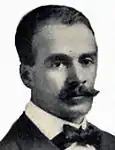1932 Chilean general election
General elections were held in Chile on 30 October 1932.[1] Arturo Alessandri of the Liberal Party was elected president, whilst the Conservative Party and Radical Party emerged as the largest parties in the Chamber of Deputies.
| |||||||||||||||||||||||||||||||||||||
| |||||||||||||||||||||||||||||||||||||
| |||||||||||||||||||||||||||||||||||||
.svg.png.webp) |
|---|
| This article is part of a series on the politics and government of Chile |
| Comptroller General |
| Constitutional Court |
|
|
Background
The election took place roughly a year after the previous election, but political and economic instability caused by the Great Depression which hit a low in mid-1932, only made the situation worse. President Montero had to resign shortly after a mutiny led by Marmaduque Grove, who headed the Socialist Republic of Chile until being overthrown by former ally Carlos Dávila who would also be overthrown, this time by Bartolome Blanche. After his downfall, Abraham Oyanedel became head of state. The return of Alessandri became so highly awaited that he won the election in a landslide ending a turbulent and bitter year for the country, being considered today as the worst one in Chilean history.
Electoral system
The presidential election was held using the absolute majority system, under which a candidate had to receive over 50% of the popular vote to be elected. If no candidate received over 50% of the vote, both houses of the National Congress would come together to vote on the two candidates that received the most votes.[2]
Results
President
| Candidate | Party | Votes | % |
|---|---|---|---|
| Arturo Alessandri | Liberal Party | 189,914 | 55.1 |
| Marmaduke Grove | Socialist | 60,856 | 17.6 |
| Héctor Rodríguez de la Cotta | Conservative Party | 47,207 | 13.7 |
| Enrique Zañartu Prieto | United Liberal Party | 42,885 | 12.4 |
| Elías Lafferte | Communist Party | 4,128 | 1.2 |
| Invalid/blank votes | 902 | – | |
| Total | 345,892 | 100 | |
| Registered voters/turnout | 464,879 | 74.4 | |
| Source: Nohlen | |||
Senate
| Party | Votes | % | Seats |
|---|---|---|---|
| Radical Party | 13 | ||
| Conservative Party | 10 | ||
| Liberal Party | 5 | ||
| Radical Socialist Party | 5 | ||
| Democratic Party | 4 | ||
| Democrat Party | 3 | ||
| New Napista Action | 2 | ||
| Doctrinal Liberal Party | 1 | ||
| United Liberal Party | 1 | ||
| Republican Social Party | 1 | ||
| Total | 45 | ||
| Source: Nohlen | |||
Chamber of Deputies
| Party | Votes | % | Seats | +/– |
|---|---|---|---|---|
| Radical Party | 59,413 | 18.1 | 34 | –5 |
| Conservative Party | 55,260 | 16.8 | 34 | +6 |
| Liberal Party | 32,645 | 9.9 | 18 | –16 |
| Democratic Party | 25,221 | 7.7 | 13 | New |
| Democrat Party | 19,819 | 6.0 | 7 | –15 |
| Unified Liberal Party | 18,885 | 5.8 | 6 | New |
| Socialist parties[a] | 18,642 | 5.7 | 5 | New |
| Radical Socialist Party | 18,174 | 5.5 | 8 | New |
| Social Republican Party | 7,009 | 2.1 | 4 | New |
| Agrarian Party | 6,580 | 1.0 | 4 | New |
| Doctrinal Liberal Party | 5,643 | 1.7 | 2 | New |
| Communist Party | 3,350 | 1.0 | 1 | New |
| Social Democracy Party | 3,029 | 0.9 | 1 | New |
| Liberal Democratic Party | 1,686 | 0.5 | 1 | New |
| Other parties | 22,265 | 6.8 | 0 | – |
| Independents | 33,116 | 10.1 | 4 | +4 |
| Invalid/blank votes | – | – | – | |
| Total | 328,207 | 100 | 142 | +10 |
| Registered voters/turnout | 429,772 | – | – | |
| Source: Nohlen | ||||
a The Socialist parties included New Public Action (9,790 votes) and Chilean Socialists (5,352 votes).[3]
Aftermath
Following the elections, three of the independent candidates elected to the Chamber of Deputies joined the Communist Party.[4]



